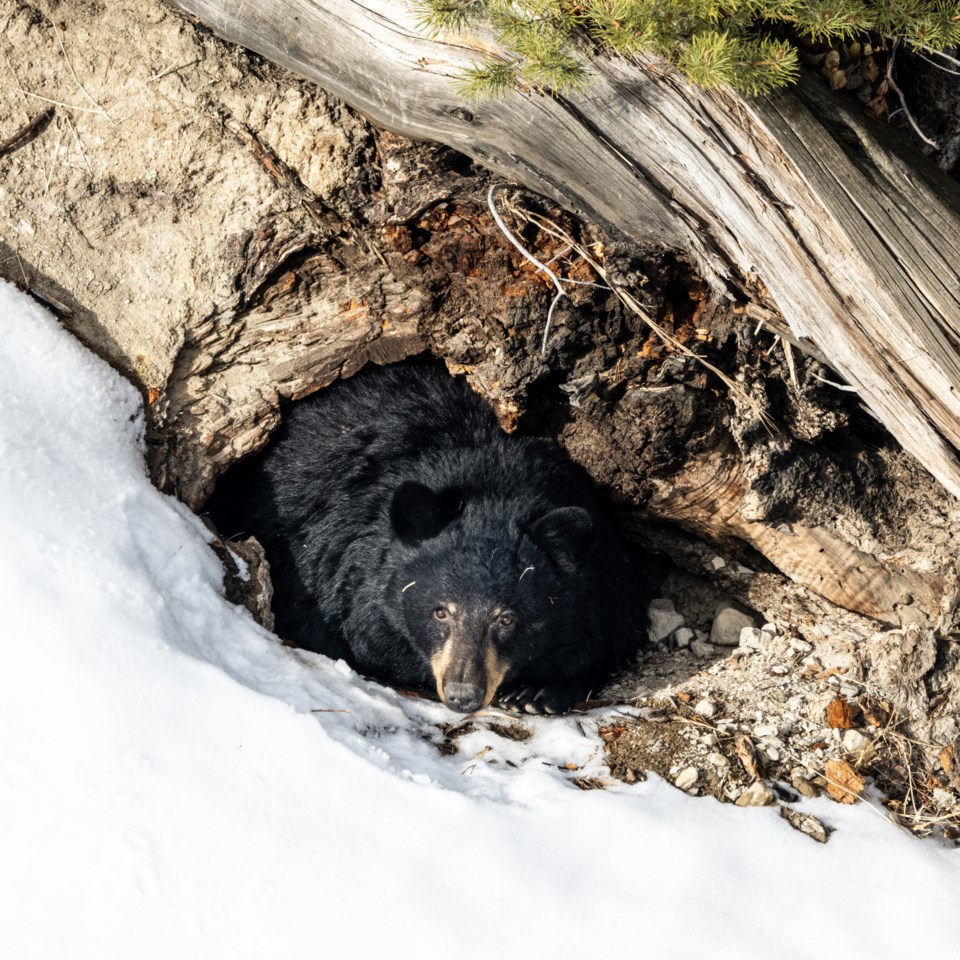Recently, the Conservation Officer Service warned residents to avoid Squamish's Mount Crumpit trails due to an "active" bear den in the area.
But aren't black bears supposed to be hibernating? And what is hibernation anyway?
The Squamish Chief turned to independent consultant and biologist—and former Squamish resident—Vanessa Isnardy for some answers.
What follows is a version of that exchange edited for length and clarity.
Q: Why do bears hibernate?
A: Hibernation is an adaptation that many animals use to deal with food scarcity and lower temperatures. Unlike deer and moose that chew their cud—aka ruminants— and can survive winters on twigs and shrubs, bears require more nutrient-rich foods as their digestive systems are much simpler.
On the coast, bears will become lethargic and enter their dens to hibernate around November to December.
During this hibernation period, a black bear's heart rate may drop to 10 beats per minute, and their body temperature drops about 3 C. During this time, they do not eat, drink, urinate or defecate. They may occasionally rouse, adjust their bedding, and return to sleep. In late January or early February, pregnant females will give birth to hairless and blind cubs weighing only about 400 g. She will nurse and care for them until they emerge in late April. Bears without offspring may emerge earlier in April.
Q: Where are dens in Squamish usually?
A: Their dens are often in the cavity of a large diameter tree, or they may also use a fallen log or shrub pile, rock cavity, or they may excavate their own.
Dens can be hard to spot, especially when they are covered in snow. Early in the season, the area will look disturbed as bedding has been gathered, and the entrance may have claw or bite marks. The inquisitive nature of dogs may lead to them discovering a bear den before the owner. Along with the year-long presence of wolves and cougars in the Squamish area, it is always best to keep our pets on established trails with us and on a leash.
High-quality black bear dens, such as the cavities of large trees, should be protected whenever possible, as they may be reused. While black bears may hibernate in valley bottoms, grizzly bears tend to hibernate at higher elevations. Coastal grizzly bears may use tree cavities like black bears or dig under an old tree and use the root mass as a roof. Farther inland, grizzly bears will seek steep north-facing slopes and dig horizontally into the face. They prefer soils suitable for digging with matted vegetation to create a stable roof and thick, insulating snow. Unlike black bears, grizzly bears rarely reuse the same den, but may return to the same area if the conditions are ideal.
Q: Do bear families have a den together, or is it usually just a sow and her cubs or a bear alone?
A: Male bears are not involved in raising cubs and always hibernate alone when mature. In fact, male bears are known to kill cubs to force females back into estrus [fertility] so they can mate.
Black bear cubs will stay with their mothers throughout the summer and den with her another winter. For grizzly bears, they often den together for a third winter.
Q: How is hibernation different for black bears than other wild animals?
A: Some may confuse hibernation and torpor. Many animals, such as hummingbirds and bats, undergo daily torpor—conserving energy at night by reducing their metabolic rate and body temperature and returning to foraging during the day. Animals that undergo repeated bouts of torpor over long periods and rely on energy reserves are considered hibernators.
Bears rely on their fat reserves, while smaller animals may gather food reserves and hibernate differently.
Chipmunks will undergo torpor over the winter in their dens but will also rouse to eat some of their stored food. If they have abundant food stores or a milder climate, they may not go into torpor as often.
Torpor and hibernation should be considered continuums along a spectrum with many variations in strategies and timings, not only amongst species but along climatic conditions.
Q: How can humans disrupt local black bears' hibernation?
A: If bears continue to have easy access to food, either through unsecured garbage, compost, fruit or bird seed, then this may delay hibernation. Occasionally, some bears may stay active late into December and early January. This leads to human-bear conflicts, which can put both people and bears at risk. Bears may also rouse in early spring to check conditions.
They may re-enter their dens and return to hibernating if they don't like what they see. It is important not to disturb bears while they are in their dens and to be aware that they can be woken from their sleep. Female bears may also defend their vulnerable cubs that cannot run away or climb trees to escape potential predators—this includes humans and our canine companions.



